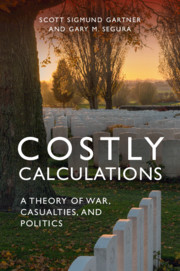Book contents
- Costly Calculations
- Costly Calculations
- Copyright page
- Dedication
- Contents
- Figures
- Tables
- Acknowledgments
- 1 Introduction
- 2 A Price Theory of War
- 3 Calculating War’s Price: What’s It Worth, and How Much Will It Cost?
- 4 The Price Theory of War in Action: Experimental Demonstrations of the Impacts of Expected Costs and Valuable War Aims
- 5 Conflict Dynamics across Space and Time: Public Opinion in the Korean and Vietnam Wars
- 6 Getting Wartime Information from Over-There to Over-Here: News Media and Social Networks
- 7 Elite Opinion Formation and Its Electoral Consequences
- 8 Conclusion: Wars, Casualties, Politics, and Policies
- Bibliography
- Index
1 - Introduction
Published online by Cambridge University Press: 18 June 2021
- Costly Calculations
- Costly Calculations
- Copyright page
- Dedication
- Contents
- Figures
- Tables
- Acknowledgments
- 1 Introduction
- 2 A Price Theory of War
- 3 Calculating War’s Price: What’s It Worth, and How Much Will It Cost?
- 4 The Price Theory of War in Action: Experimental Demonstrations of the Impacts of Expected Costs and Valuable War Aims
- 5 Conflict Dynamics across Space and Time: Public Opinion in the Korean and Vietnam Wars
- 6 Getting Wartime Information from Over-There to Over-Here: News Media and Social Networks
- 7 Elite Opinion Formation and Its Electoral Consequences
- 8 Conclusion: Wars, Casualties, Politics, and Policies
- Bibliography
- Index
Summary
The personal costs of war — military dead and injured—are the most salient measure of war costs and the primary instrument through which war affects domestic politics. We posit a framework for understanding war initiation, war policy, and war termination in democratic polities, and for understanding the role that citizens and their deaths through conflict play in those policy choices. We believe that war support derives from individuals’ calculations of a war’s value and cost. High-value conflicts are more likely to be supported than low-value conflicts. Conversely, low-cost conflicts are more likely to occur andtohave durable support, while high-cost conflicts are likely to see rapid erosion of support when they are fought. We develop a comprehensive theoretical approach and examine these arguments with a variety of empirical methods in multiple wars, conducting analyses of tens of thousands of citizens across a wide variety of historical and hypothetical conditions. We also analyze the ways that military casualty information travels from distant battlefields to the homefront and address policy implications.
- Type
- Chapter
- Information
- Costly CalculationsA Theory of War, Casualties, and Politics, pp. 1 - 38Publisher: Cambridge University PressPrint publication year: 2021
- 1
- Cited by

